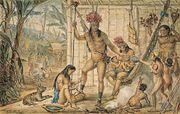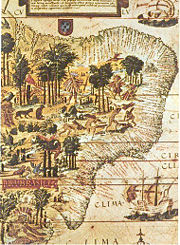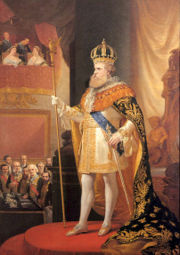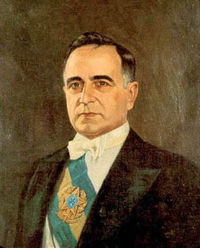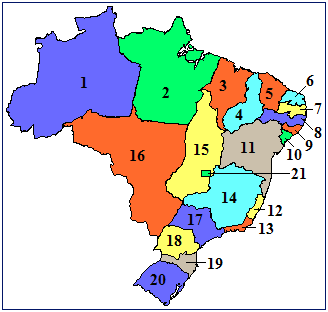Brazil
From Roach Busters
(→History) |
|||
| Line 120: | Line 120: | ||
On July 23, 1840, Pedro II was crowned Emperor. His government was marked by a substantial rise in coffee exports, the War of the Triple Alliance, and the end of slave trade from Africa in 1865, although slavery in Brazilian territory would only be abolished in 1888. Brazil stopped trading slaves from Africa in 1850, with the Eusébio de Queirós law, and abandoned slavery altogether in 1888, thus becoming the last country of the Americas to ban slavery. When slavery was finally abolished, a large influx of European immigrants took place. By the 1870s, the Emperor's control of domestic politics had started to deteriorate in face of crises with the Catholic Church, the Army and the slaveholders. The Republican movement slowly gained strength. In the end, the empire fell due to a military coup d'etat and because the dominant classes no longer needed it to protect their interests and deeply resented the abolition of slavery. Indeed, imperial centralization ran counter to their desire for local autonomy. By 1889 Pedro II had stepped down and the Republican system had been adopted to Brazil. | On July 23, 1840, Pedro II was crowned Emperor. His government was marked by a substantial rise in coffee exports, the War of the Triple Alliance, and the end of slave trade from Africa in 1865, although slavery in Brazilian territory would only be abolished in 1888. Brazil stopped trading slaves from Africa in 1850, with the Eusébio de Queirós law, and abandoned slavery altogether in 1888, thus becoming the last country of the Americas to ban slavery. When slavery was finally abolished, a large influx of European immigrants took place. By the 1870s, the Emperor's control of domestic politics had started to deteriorate in face of crises with the Catholic Church, the Army and the slaveholders. The Republican movement slowly gained strength. In the end, the empire fell due to a military coup d'etat and because the dominant classes no longer needed it to protect their interests and deeply resented the abolition of slavery. Indeed, imperial centralization ran counter to their desire for local autonomy. By 1889 Pedro II had stepped down and the Republican system had been adopted to Brazil. | ||
| + | ===Early republic=== | ||
| + | [[Image:Fo_g0039.jpg|Getúlio Dornelles Vargas|thumb|left|200px|Getúlio Dornelles Vargas (President of Brazil 1930–1945, 1951-1954).]] | ||
| + | Pedro II was deposed on November 15, 1889 by a Republican military coup led by general Deodoro da Fonseca, who became the country’s first ''de facto'' president through military ascension. The country’s name became the Republic of the United States of Brazil. From 1889 to 1930, the dominant states of São Paulo and Minas Gerais alternated control of the presidency. A military junta took control in 1930. Getúlio Vargas took office soon after, and would remain as dictatorial ruler (with a brief democratic period in between), until 1945. He was re-elected in 1951 and stayed in office until his suicide in 1954. After 1930, successive governments continued industrial and agricultural growth and the development of the vast interior of Brazil. Juscelino Kubitschek's office years (1956-1961) were marked by the political campaign motto of plunging ''50 anos em 5'' (English: "Fifty years of development in five"). | ||
| - | + | ===Military junta=== | |
| - | + | [[Image:1964coupRJ.jpg|250px|thumb|right|[[Brazilian Army]] M41 tanks at President Vargas Avenue in Rio de Janeiro during the 1964 Brazilian coup d'état on March 31, 1964.]] | |
| - | + | to be added | |
| - | + | ||
| - | + | ||
| - | + | ||
| - | + | ||
| - | + | ||
| - | + | ||
| - | + | ||
| - | + | ||
| - | + | ||
| - | + | ||
| - | + | ||
| - | + | ||
| - | + | ||
| - | + | ||
| - | + | ||
| - | + | ||
| - | + | ||
| - | + | ||
| - | + | ||
| - | + | ||
| - | + | ||
| - | + | ||
| - | + | ||
| - | + | ||
| - | + | ||
| - | + | ||
| - | + | ||
| - | + | ||
| - | + | ||
| - | + | ||
| - | + | ||
| - | + | ||
| - | + | ||
| - | + | ||
| - | + | ||
| - | + | ||
| - | + | ||
| - | + | ||
| - | + | ||
| - | + | ||
| - | + | ||
| - | + | ||
| - | + | ||
| - | + | ||
| - | + | ||
| - | + | ||
| - | + | ||
| - | + | ||
| - | + | ||
| - | + | ||
| - | + | ||
| - | + | ||
| - | + | ||
| - | + | ||
| - | + | ||
| - | + | ||
| - | + | ||
| - | + | ||
| - | + | ||
| - | + | ||
| - | + | ||
| - | + | ||
| - | + | ||
| - | + | ||
| - | + | ||
| - | + | ||
| - | + | ||
| - | + | ||
| - | + | ||
| - | + | ||
| - | + | ||
| - | + | ||
| - | + | ||
| - | + | ||
| - | + | ||
| - | + | ||
| - | + | ||
| - | + | ||
| - | + | ||
| - | + | ||
| - | + | ||
| - | + | ||
| - | + | ||
| - | + | ||
| - | + | ||
| - | + | ||
| - | + | ||
| - | + | ||
| - | + | ||
| - | + | ||
| - | + | ||
| - | + | ||
| - | + | ||
| - | + | ||
| - | + | ||
| - | + | ||
| - | + | ||
| - | + | ||
| - | + | ||
| - | + | ||
| - | + | ||
| - | + | ||
| - | + | ||
| - | + | ||
| - | + | ||
| - | + | ||
| - | + | ||
| - | + | ||
| - | + | ||
| - | + | ||
| - | + | ||
| - | + | ||
| - | + | ||
| - | + | ||
| - | + | ||
| - | + | ||
| - | + | ||
| - | + | ||
| - | + | ||
| - | + | ||
| - | + | ||
| - | + | ||
| - | + | ||
| - | + | ||
| - | + | ||
| - | + | ||
| - | + | ||
| - | + | ||
| - | + | ||
| - | + | ||
| - | + | ||
| - | + | ||
| - | + | ||
| - | + | ||
| - | + | ||
| - | + | ||
==States of Brazil== | ==States of Brazil== | ||
Revision as of 00:07, 16 June 2008
| República dos Estados Unidos do Brasil Republic of the United States of Brazil | |
| | |
 | 
|
| Flag | Coat of arms |
| | |
| Motto "Ordem e Progresso" (Portuguese) "Order and Progress" | |
| | |
| Anthem Hino Nacional Brasileiro (National Anthem of Brazil) | |
| | |

| |
| | |
| Capital Largest city | Brasília 15°45′S 47°57′W São Paulo |
| | |
| Official languages | Portuguese |
| | |
| Demonym | Brazilian |
| | |
| Government - President - Vice-President | Unitary presidential republic João de Oliveira Mendonça Afonso Branco |
| | |
| Independence - Declared - Recognized - Republic - Coup d'état | from Portugal September 7, 1822 August 29, 1825 November 15, 1889 March 31, 1964 |
| | |
| Area - Total - Water (%) | 8,514,877 km² 3,287,597 sq mi 0.65 |
| | |
| Population - 2008 estimate - 2007 census - Density | 186,757,608 183,987,291 22/km² 57/sq mi |
| | |
| GDP (PPP) - Total - Per capita | 2007 estimate $1.804 trillion $11,873 |
| | |
| GDP (nominal) - Total - Per capita | 2007 estimate $1.313 trillion $6,842 |
| | |
| Gini (2005) | |
| | |
| HDI (2005) | |
| | |
| Currency | Real (R$) (BRL)
|
| | |
| Time zone - Summer (DST) | BRT (UTC -2 to -4) BRST (UTC -2 to -3) |
| | |
| Internet TLD | .br |
| | |
| Calling code | +55 |
Brazil (Portuguese: Brasil), officially the Republic of the United States of Brazil (Portuguese: República dos Estados Unidos do Brasil) is a country in South America. With a population of over 185 million and an area of 8,514,877 km² (3,287,597 sq mi), it is one of the largest and most populous countries in the world. Bounded by the Atlantic Ocean on the east, Brazil has a coastline of over 7,491 kilometers (4,655 mi). It is bordered on the north by Venezuela, Suriname, Guyana and the overseas department of French Guiana; and on the northwest, west, southwest, and south by the Confederate States of Latin America. Numerous archipelagos are part of the Brazilian territory, such as Fernando de Noronha, Rocas Atoll, Saint Peter and Paul Rocks, and Trindade and Martim Vaz.
Brazil was a colony of Portugal from the landing of Pedro Álvares Cabral in 1500 until its independence in 1822. Initially independent as the Empire of Brazil, the country has been a republic since 1889, although the bicameral legislature, now called Congress, dates back to 1824, when the first constitution was ratified. Its current constitution defines Brazil as a federal republic, but in practice the country is a unitary state in which the states enjoy little autonomy. Brazil comprises 21 States (including the Distrito Federal, or "Federal District") and 5,564 Municipalities.
Economic reforms have transformed Brazil into a great power. The country is a founding member of the League of Nations. A predominantly Roman Catholic, Portuguese-speaking, and multiethnic society, Brazil is also home to a diversity of wildlife, natural environments, and extensive natural resources in a variety of protected habitats.
Contents |
History
Origins
Within Brazil's current borders, most native tribes who were living in the land by the year 1500 are thought to have descended from the first wave of migrants from North Asia (Siberia), who are believed to have crossed the Bering Land Bridge at the end of the last Ice Age, around 9000 BC. At the time of European discovery, the territory of modern Brazil had as many as 2,000 nations and tribes, an estimated total population of nearly 3 million Amerindians. A somewhat dated linguistic survey found 188 living indigenous languages with 155,000 total speakers. On 18 January 2007, Fundação Nacional do Índio reported that it had confirmed the presence of 67 different uncontacted tribes in Brazil, up from 40 in 2005. With this addition, Brazil is now confirmed as having the largest number of uncontacted peoples in the world, even more than the island of New Guinea. When the Portuguese arrived in 1500, the Amerindians were mostly semi-nomadic tribes, living mainly on the coast and along the banks of major rivers.
Unlike Christopher Columbus who thought he had reached the East Indies, the Portuguese, most notably by Vasco da Gama, had already reached India via the Indian Ocean route when they reached Brazil. Nevertheless, the word índios ("Indians") was by then established to designate the peoples of the New World and stuck being used today in the Portuguese language, while the people of India are called indianos in order to distinguish the two peoples. Initially, the Europeans saw the natives as noble savages, and miscegenation of the population began right away. Tribal warfare, cannibalism, and the pursuit of brazilwood for its treasured red dye convinced the Portuguese that they should civilize the Amerindians.
Colonization
Initially Portugal had little interest in Brazil, mainly because of high profits gained through commerce with Indochina. After 1530, the Portuguese Crown devised the Hereditary Captaincies system to effectively occupy its new colony, and later took direct control of the failed captaincies. Although temporary trading posts were established earlier to collect brazilwood, used as a dye, with permanent settlement came the establishment of the sugar cane industry and its intensive labor. Several early settlements were founded across the coast, among them the colonial capital, Salvador, established in 1549 at the Bay of All Saints in the north, and the city of Rio de Janeiro on March 1567, in the south. The Portuguese colonists adopted an economy based on the production of agricultural goods that were exported to Europe. Sugar became by far the most important Brazilian colonial product until the early 18th century. Even though Brazilian sugar was reputed as being of high quality, the industry faced a crisis during the 17th and 18th centuries when the Dutch and the French started producing sugar in the Antilles, located much closer to Europe, causing sugar prices to fall.
During the 18th century, private explorers who called themselves the Bandeirantes found gold and diamond deposits in the state of Minas Gerais. The exploration of these mines were mostly used to finance the Portuguese Royal Court's expenditure with both the preservation of its Global Empire and the support of its luxury lifestyle at mainland. The way in which such deposits were exploited by the Portuguese Crown and the powerful local elites, however, burdened colonial Brazil with excessive taxes. Some popular movements supporting independence came about against the taxes established by the colonial government, such as the Tiradentes in 1789, but the secessionist movements were often dismissed by the authorities of the ruling colonial regime. Gold production declined towards the end of the 18th century, starting a period of relative stagnation of the Brazilian hinterland. Both Amerindian and African slaves' man power were largely used in Brazil's colonial economy.
In contrast to the neighboring Spanish possessions in South America, the Portuguese colony of Brazil kept its territorial, political and linguistic integrity due to the action of the Portuguese administrative effort. Although the colony was threatened by other nations across the Portuguese rule era, in particular by Dutch and French powers, the authorities and the people ultimately managed to protect its borders from foreign attacks. Portugal even had to send bullion to Brazil, a spectacular reversal of the colonial trend, in order to protect the integrity of the colony.
Empire
In 1808, the Portuguese court, fleeing from Napoleon’s troops who had invaded Portugal, established themselves in the city of Rio de Janeiro, which thus became the seat of government of Portugal and the entire Portuguese Empire, even though being located outside of Europe. Rio de Janeiro was the capital of the Portuguese empire from 1808 to 1815. After then the United Kingdom of Portugal, Brazil and the Algarves (1815-1825) was created with Lisbon as its capital. After João VI returned to Portugal in 1821, his heir-apparent Pedro became regent of the Kingdom of Brazil, within the United Kingdom of Portugal, Brazil and the Algarves. Following a series of political incidents and disputes, Brazil achieved its independence from Portugal on September 7, 1822. On October 12, 1822, Dom Pedro became the first Emperor of Brazil, being crowned on December 1, 1822. Portugal would recognize Brazil as an independent country in 1825.
In 1824, Pedro closed the Constituent Assembly, stating that the body was "endangering liberty". Pedro then produced a constitution modeled on that of Portugal (1822) and France (1814). It specified indirect elections and created the legislative, executive and judicial branches of government; however, it also added a fourth branch, the "moderating power", to be held by the Emperor. Pedro's government was considered economically and administratively inefficient. Political pressures eventually made the Emperor step down on April 7, 1831. He returned to Portugal leaving behind his five-year-old son Pedro II. Until Pedro II reached maturity, Brazil was governed by regents from 1831 to 1840. The regency period was turbulent and marked by numerous local revolts including the Male Revolt, the largest urban slave rebellion in the Americas, which took place in Bahia in 1835.
On July 23, 1840, Pedro II was crowned Emperor. His government was marked by a substantial rise in coffee exports, the War of the Triple Alliance, and the end of slave trade from Africa in 1865, although slavery in Brazilian territory would only be abolished in 1888. Brazil stopped trading slaves from Africa in 1850, with the Eusébio de Queirós law, and abandoned slavery altogether in 1888, thus becoming the last country of the Americas to ban slavery. When slavery was finally abolished, a large influx of European immigrants took place. By the 1870s, the Emperor's control of domestic politics had started to deteriorate in face of crises with the Catholic Church, the Army and the slaveholders. The Republican movement slowly gained strength. In the end, the empire fell due to a military coup d'etat and because the dominant classes no longer needed it to protect their interests and deeply resented the abolition of slavery. Indeed, imperial centralization ran counter to their desire for local autonomy. By 1889 Pedro II had stepped down and the Republican system had been adopted to Brazil.
Early republic
Pedro II was deposed on November 15, 1889 by a Republican military coup led by general Deodoro da Fonseca, who became the country’s first de facto president through military ascension. The country’s name became the Republic of the United States of Brazil. From 1889 to 1930, the dominant states of São Paulo and Minas Gerais alternated control of the presidency. A military junta took control in 1930. Getúlio Vargas took office soon after, and would remain as dictatorial ruler (with a brief democratic period in between), until 1945. He was re-elected in 1951 and stayed in office until his suicide in 1954. After 1930, successive governments continued industrial and agricultural growth and the development of the vast interior of Brazil. Juscelino Kubitschek's office years (1956-1961) were marked by the political campaign motto of plunging 50 anos em 5 (English: "Fifty years of development in five").
Military junta

to be added
States of Brazil
- Amazonas
- Pará
- Maranhão
- Piauí
- Ceará
- Rio Grande do Norte
- Paraíba
- Pernambuco
- Alagoas
- Sergipe
- Bahia
- Espírito Santo
- Rio de Janeiro
- Minas Gerais
- Goiás
- Mato Grosso
- São Paulo
- Paraná
- Santa Catarina
- Rio Grande do Sul
- Distrito Federal
List of Brazilian states
| State | Abbreviation | Capital | Area | Population (2005) | Density |
|---|---|---|---|---|---|
| Alagaos | AL | Maceió | 27,767.7 km² | 3,015,912 | 108.61 |
| Amazonas | AM | Manaus | 1,947,626.1 km² | 4,279,690 | 2.2 |
| Bahia | BA | Salvador | 564,692.7 km² | 13,815,334 | 24.46 |
| Ceará | CE | Fortazela | 148,825.6 km² | 8,097,276 | 54.40 |
| Distrito Federal | DF | Brasília | 5,802 km² | 2,383,784 | 410.9 |
| Espírito Santo | ES | Vitória | 46,077.5 km² | 3,408,365 | 73.97 |
| Goiás | GO | Goiânia | 623,529.7 km² | 9,258,753 | 14.85 |
| Maranhão | MA | São Luís | 331,983.3 km² | 6,103,327 | 18.38 |
| Mato Grosso | MT | Cuiabá | 1,498,059.1 km² | 6,602,336 | 4.4 |
| Minas Gerais | MG | Belo Horizonte | 586,528.3 km² | 19,237,450 | 32.79 |
| Pará | PA | Belém | 1,390,504.1 km² | 7,565,173 | 5.44 |
| Paraíba | PB | João Pessoa | 56,439.8 km² | 3,595,886 | 63.71 |
| Paraná | PR | Curitiba | 199,314.9 km² | 10,261,856 | 51.48 |
| Pernambuco | PE | Recife | 98,311.6 km² | 8,413,593 | 85.58 |
| Piauí | PI | Teresina | 251,529.2 km² | 3,006,885 | 11.95 |
| Rio de Janeiro | RJ | Rio de Janeiro | 43,696.1km² | 15,383,407 | 352.05 |
| Rio Grande do Norte | RN | Natal | 52,796.8 km² | 3,003,087 | 56.88 |
| Rio Grande do Sul | RS | Porto Alegre | 281,748.5 km² | 10,845,087 | 38.49 |
| Santa Catarina | SC | Florianópolis | 95,346.2 km² | 5,866,568 | 61.53 |
| São Paulo | SP | São Paulo | 248,209.4 km² | 40,442,795 | 162.93 |
| Sergipe | SE | Aracaju | 21,910.3 km² | 1,967,761 | 89.81 |
Politics
to be added
The composition of the current cabinet is as follows:
- Minister of Aeronautics: Sérgio Fortes
- Minister of Agriculture: Antônio Corrêa Prestes
- Minister of Communications: Vítor Ribeiro
- Minister of Development, Industry, and Commerce: Augusto Geisel
- Minister of Education: Mário Rodrigues
- Minister of External Relations: Deodoro Cabral
- Minister of Finance: José Salazar
- Minister of Health: Francisco Pinheiro
- Minister of Justice: Paulo Inácio dos Santos
- Minister of Labor and Employment: Afonso Luiza Rezende
- Minister of Mines and Energy: Luís de Campos Meirelles
- Minister of the Navy: Carlos Guimarães Rosa
- Minister of Planning, Budget, and Management: Gilberto de Alencar Tavares
- Minister of Transport: Fernando Cautiero e Silva
- Minister of War: João Vieira Soares
